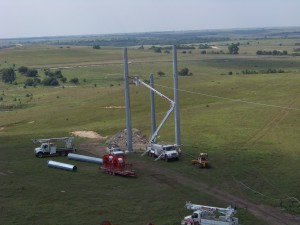February 2009 Vol. 64 No.2
General
Michels Completes Largest On-shore Wind Turbine

Remember when Dorothy arrived in Oz and said she had a feeling she wasn’t in Kansas anymore? Drop Dorothy, today, just eight miles south of Concordia in central Kansas and she may say the same thing.
The recently completed Meridian Way Wind Farm sits at 1,650 feet of elevation in Cloud County and has 67 Vestas V90 3.0MW turbines – the largest on shore wind turbine currently installed in the United States.
After successfully winning a competitively bid project, Michels Wind Energy was approached by Texas based, wind farm developer and operator, Horizon Wind Energy, in the late part of 2007 with a “balance of plant” contract. The BOP was signed in February of 2008 and work began shortly after that on the 201 megawatt wind farm.
This wasn’t the first project Michels Wind Energy and Horizon Wind have worked together on. Horizon hired Michels as the BOP contractor to construct 120, 1.65MW wind turbine generators, (WTG) in Twin Groves, IL. That project’s BOP work was also successfully completed last summer.

Heavy rains
Crews from Michels arrived on the Meridian Way job site to begin construction during what turned out to be the rainiest year in Kansas’ history. “When we arrived in February, it was cold and snowed almost every day,” says Project Manager Scott Robinson.
Despite the cold weather, crews went to work on building a 23 acre lay-down yard. In late March and early April, just when the snow started to melt, the record breaking rains began. “Sometimes the rain would turn into hail but either way, all of our teams decided it would be for the best if we just keep forging ahead, despite the weather – or at least until we couldn’t anymore,” adds Michels Civil Project Assistant Tyler Sutton.
The first task was to begin reconstruction on 16 miles of the local county road. Michels put their safety people into place and crews went to work. After the county road upgrades were completed, work began on 20 miles worth of access roads. Both tasks were completed ahead of schedule.
Working in heavy rains is unusual for those who spend the majority of their time working in dirt. One of the biggest challenges workers faced while dealing with the unusual stormy weather was preparing for the rain while work on the wind farm progressed. “We needed to stay one step ahead of the weather and make sure people stayed safe by filling in any holes around the job site and then moving onto whatever else needed to be done,” says Robinson.
With that philosophy in place, Michels completed construction on 163,000 feet of trench for the underground electrical collection system. Crews, despite the weather, managed to complete the trench ahead of schedule.
Largest on-shore turbine
Construction of the Meridian Wind Farm included assembling 3.0 MW turbines – the largest on shore wind turbine in the United States. Each turbine is 262 feet high with a rotor that is 295 feet in diameter.
The two project substations and 16 miles of new overhead transmission lines were designed with future expansion in mind.
The entire project spans approximately 18,000 acres; however, only 250 acres or 1.3 percent of the land area was taken out of crop production for the turbines, roads, operations facility and the substation.
Environmental issues were a priority. The Meridian Way Wind Farm was built to prevent the annual emission of approximately 600,000 tons of carbon dioxide from going into the atmosphere.
Another advantage to the environment with the wind farm is the displacement of 14,000 pounds of mercury each year. Experts say the avoided pollution is equivalent to taking 60,000 cars off of the road.
Rubber tire cranes were used to help with the foundation, moving rebar and setting forms. The RT cranes were also used to help facilitate transmission lines.
Crews were able to utilize the Telebelt or concrete conveyor in an innovative way to assist in moving concrete from the truck to the job site as quickly and efficiently as possible.
Safety was a key factor on this job. “Throughout the duration of the work Michels has done here, we have made sure to have a safety person, on site, the whole time,” explained Sutton.
The strategy paid off for Michels. “Despite heavy thunderstorms, loose soil, hail and major lightening storms, crews continued to work safely and ahead of schedule. That’s always a good thing,” added Robinson.
Crews from Michels finished the project on time and estimate full restoration of temporary construction areas back to native conditions by the end of the year.
FOR MORE INFORMATION:
Michels Corporation, (920) 583 3132, www.michels.us




Comments